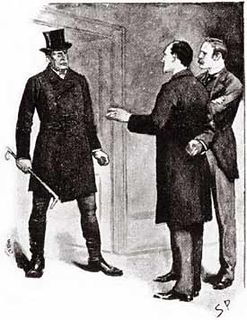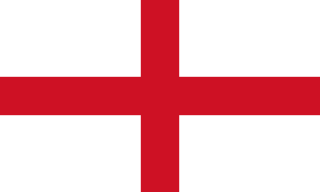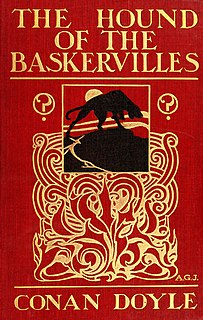
Mycroft Holmes is a fictional character appearing in stories written by Sir Arthur Conan Doyle. He is the elder brother of detective Sherlock Holmes. He is described as having abilities of deduction and knowledge exceeding even those of his brother, though their practical use is limited by his poor physique and dislike of fieldwork.

"The Final Problem" is a short story by Sir Arthur Conan Doyle featuring his detective character Sherlock Holmes. It was first published in Strand Magazine under the title "The Adventure of the Final Problem" in December 1893. It appears in book form as part of the collection The Memoirs of Sherlock Holmes. This story, set in 1891, introduced Holmes's greatest opponent, the criminal mastermind Professor James Moriarty. Conan Doyle later ranked "The Final Problem" fourth on his personal list of the twelve best Holmes stories.
The New Adventures of Sherlock Holmes is an old-time radio show which aired in the USA from 1939 to 1950.

"The Red-Headed League" is one of the 56 Sherlock Holmes short stories written by Sir Arthur Conan Doyle. It first appeared in The Strand Magazine in August 1891, with illustrations by Sidney Paget. Conan Doyle ranked "The Red-Headed League" second in his list of his twelve favourite Holmes stories. It is also the second of the twelve stories in The Adventures of Sherlock Holmes, which was published in 1892.

"The Adventure of the Speckled Band" is one of the 56 short Sherlock Holmes stories written by Sir Arthur Conan Doyle. It is the eighth of the twelve stories collected in The Adventures of Sherlock Holmes. It is one of four Sherlock Holmes stories that can be classified as a locked room mystery. The story was first published in Strand Magazine in February 1892, with illustrations by Sidney Paget. It was published under the different title "The Spotted Band" in New York World in August 1905. Doyle later revealed that he thought this was his best Holmes story.

"The Adventure of the Abbey Grange", one of the 56 Sherlock Holmes short stories written by Sir Arthur Conan Doyle, is one of 13 stories in the cycle collected as The Return of Sherlock Holmes.

Nicholas Briggs is an English actor, writer, director, sound designer, composer and voice actor predominantly associated with the BBC science fiction television series Doctor Who and its various spin-offs, particularly as the voice of the Daleks and the Cybermen.

Bert Coules is an English writer, mainly for the BBC, who has produced a number of adaptations and original works. He works mainly in radio drama but also writes for TV and the stage.

Without a Clue is a 1988 British comedy film directed by Thom Eberhardt and starring Michael Caine and Ben Kingsley. It is based on Sir Arthur Conan Doyle's characters from the Sherlock Holmes stories but reverses the precedence of the characters in comedic style.
The stories of Sherlock Holmes by Sir Arthur Conan Doyle were very popular as adaptations for the stage, and later film, and still later television. The four-volumes of the Universal Sherlock Holmes (1995) compiled by Ronald B. De Waal lists over 25,000 Holmes-related productions and products. They include the original writings, "together with the translations of these tales into sixty-three languages, plus Braille and shorthand, the writings about the Writings or higher criticism, writings about Sherlockians and their societies, memorials and memorabilia, games, puzzles and quizzes, phonograph records, audio and video tapes, compact discs, laser discs, ballets, films, musicals, operettas, oratorios, plays, radio and television programs, parodies and pastiches, children's books, cartoons, comics, and a multitude of other items — from advertisements to wine — that have accumulated throughout the world on the two most famous characters in literature."
Sherlock Holmes has long been a popular character for pastiche, Holmes-related work by authors and creators other than Arthur Conan Doyle. Their works can be grouped into four broad categories:

All-Consuming Fire is an original novel written by Andy Lane and based on the long-running British science fiction television series Doctor Who. The novel is a crossover with Arthur Conan Doyle's fictional detective Sherlock Holmes featuring the characters of both Holmes and Doctor Watson, and also with H. P. Lovecraft's Cthulhu Mythos. A prelude to the novel, also penned by Lane, appeared in Doctor Who Magazine issue 213.
The Newly Discovered Casebook of Sherlock Holmes was a BBC Radio 2 comedy series written by Tony Hare. It starred Roy Hudd, Chris Emmett, Jeffrey Holland, and June Whitfield, and was broadcast between 16 January 1999, to 20 February 1999. It has since been re-broadcast on BBC Radio 4 Extra.

The Adventures of Sherlock Holmes and Dr. Watson is a series of Soviet television films portraying Arthur Conan Doyle's fictional English detective, starting in 1979. They were directed by Igor Maslennikov. In 2006, Vasily Livanov became an Honorary MBE for his portrayal of Sherlock Holmes.

Sherlock is a British crime drama television series based on Sir Arthur Conan Doyle's Sherlock Holmes detective stories. Created by Steven Moffat and Mark Gatiss, it stars Benedict Cumberbatch as Sherlock Holmes and Martin Freeman as Doctor John Watson. Thirteen episodes have been produced, with four three-part series airing from 2010 to 2017, and a special episode that aired on 1 January 2016. The series is set in the present day, while the one-off special features a Victorian period fantasy resembling the original Holmes stories. Sherlock is produced by the British network BBC, along with Hartswood Films, with Moffat, Gatiss, Sue Vertue and Rebecca Eaton serving as executive producers. The series is supported by the American station WGBH Boston for its Masterpiece anthology series on PBS, where it also airs in the United States. The series is primarily filmed in Cardiff, Wales, with North Gower Street in London used for exterior shots of Holmes and Watson's 221B Baker Street residence.

John H. Watson, known as Dr Watson, is a fictional character in the Sherlock Holmes stories by Sir Arthur Conan Doyle. Watson is Sherlock Holmes' friend, assistant and sometime flatmate, and the first person narrator of all but four of these stories. He is described as the typical Victorian-era gentleman, unlike the more eccentric Holmes. He is astute, although he can never match his friend's deductive skills.

The Sign of Four is a 1983 British made-for-television mystery film directed by Desmond Davis and starring Ian Richardson and David Healy. The film is based on Sir Arthur Conan Doyle's novel of the same name, the second novel to feature Sherlock Holmes and Doctor Watson.
The Hound of the Baskervilles (1982) is a British television serial made by the BBC, produced by Barry Letts, directed by Peter Duguid and starring Tom Baker as Sherlock Holmes and Terence Rigby as Doctor Watson. The serial is based on Arthur Conan Doyle's Sherlock Holmes novel The Hound of the Baskervilles. The music score was composed and conducted by Carl Davis.

Holmes & Watson is a 2018 American mystery buddy comedy film written and directed by Etan Cohen. The film stars Will Ferrell and John C. Reilly as the eponymous characters Sherlock Holmes and Dr. Watson, with Rebecca Hall, Rob Brydon, Steve Coogan, and Ralph Fiennes in supporting roles. The plot follows the famed detective duo as they set out to find the culprit behind a threat at Buckingham Palace.
The Three Garridebs is a 1937 television presentation that aired on NBC, based on Sir Arthur Conan Doyle's 1924 story "The Adventure of the Three Garridebs". Louis Hector played Sherlock Holmes, the first actor to do so on television.


















